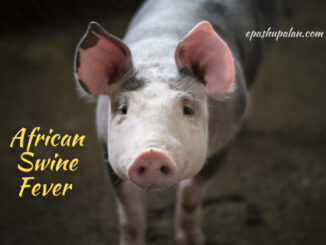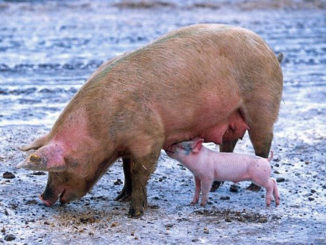Introduction
Classical swine fever (CSF), often known as Hog cholera, is caused by the CSF virus (CSFV), which can cause significant morbidity and mortality in pigs. It has tremendous impact on pig industry and is therefore notifiable to the World Organization for Animal Health (OIE). CSFV is a member of the Flaviviridae family, which also includes the Flavivirus, Hepacivirus, and Pegivirus genera. Bovine viral diarrhoea virus-1 (BVDV-1), BVDV-2, and border disease virus (BDV) are further members of the Pestivirus genus that cause major other diseases in animals.
About virus
Classical swine fever virus is a small, enveloped RNA virus with icosahedral symmetry. There are four structural and seven non-structural proteins in the genome, which has a total length of 12,300 base. The core protein (C) and envelope glycoproteins E1, E2, and Erns are the four structural proteins found in enveloped virus particles. The core encloses the positive single-stranded RNA. Glycoproteins E2 and Erns are necessary for viral attachment, and the initial contact with the host cell is mediated through the Erns which interacts with glycosaminoglycans.
Transmission
The only natural reservoirs are pigs and wild boar. The CSFV can spread horizontally and vertically. Horizontal transmission happens when infected and susceptible pigs come into direct touch. Indirect contact with animals and animal products through mechanical transmission, persons, equipment, swill feeding, and trade of animals and animal products, livestock trucks, slurry, and other animals also plays a significant impact.
Pathogenesis
CSFV is transmitted through the oronasal route, by direct or indirect contact with infected pigs, as well as through consumption of contaminated feed. Vertical transmission from infected sows to their offspring can also occur. The virus may also be transmitted through insemination. CSFV has also been reported to survive over long periods in cooled and frozen meat and pork derivate products, which can be reservoirs for the virus.
The virus infects the epithelial cells of tonsillar crypts first, regardless of the route of infection, and then spreads to lymphoid tissues. The virus enters the lymphatic capillaries and travels to the regional lymph nodes, where it enters the efferent blood capillaries, causing viremia. The virus then replicates in the bone marrow as well as secondary lymphoid organs such the spleen, lymph nodes, and lymphoid tissues associated with the small intestine. The parenchymatous organs are attacked late in the viremic phase. CSFV prefers endothelial cells and the mononuclear phagocyte system, which includes macrophages and dendritic cells (DCs)
CSFV infection causes the immune system to break down, which is thus unable to manage disease progression due to an abnormal pro-inflammatory response (known as “cytokine storm”). The disease is associated with severe lymphopenia and lymphocyte apoptosis, thrombocytopenia, platelet aggregation.
Clinical Signs
Acute (transient or deadly), chronic and persistent are the three types of classic swine fever. The acute phase is marked by unspecific (commonly referred to as “atypical”) clinical indications such as high fever, anorexia, gastrointestinal problems, overall weakness, and conjunctivitis during the first two weeks after infection. Neurological symptoms such as incoordination, paresis, paralysis, and convulsions might appear two to four weeks after infection. Skin haemorrhages or cyanosis can arise in several parts of the body at the same time, including the ears, limbs, and ventral abdomen. Because of its capacity to breach the placental barrier, the virus can infect the developing fetus, which could lead to persistent infection in the piglets. While sows frequently display very minor clinical indications, infection can result in the absorption or mummification of foetuses, as well as abortions or stillbirths, depending on the stage of pregnancy.
Diagnosis
The diagnosis depends on field clinical signs, gross pathology findings, indirect detection (serology), and direct detection. The OIE manual recognises a variety of assays for detecting CSFV as acceptable, including fluorescent antibody testing, immuno-peroxidase staining, antigen capture ELISA, virus isolation in cell culture, and RT-PCR.
Vaccines
Multiple live attenuated vaccines are currently commercially available and have been demonstrated to be both safe and effective against CSFV infection. The lapinized Chinese vaccine (C-strain), for example, was created by Chinese researchers in the 1950s and has been widely used to control CSF in China and many other countries.
| The content of the articles are accurate and true to the best of the author’s knowledge. It is not meant to substitute for diagnosis, prognosis, treatment, prescription, or formal and individualized advice from a veterinary medical professional. Animals exhibiting signs and symptoms of distress should be seen by a veterinarian immediately. |






Be the first to comment